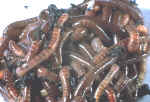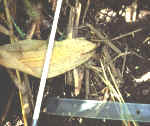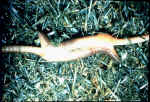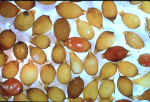The Soil Biology Primer
Chapter 8: EARTHWORMS
by Clive A. Edwards, The Ohio State University
THE LIVING SOIL: EARTHWORMS
Of all the members of the soil food web, earthworms need the least
introduction. Most people become familiar with these soft, slimy,
invertebrates at a young age. Earthworms are hermaphrodites, meaning that
they exhibit both male and female characteristics.
They are major decomposers of dead and decomposing organic matter, and
derive their nutrition from the bacteria and fungi that grow upon these
materials. They fragment organic matter and make major contributions to
recycling the nutrients it contains.
Earthworms occur in most temperate soils and many tropical soils. They
are divided into 23 families, more than 700 genera, and more than 7,000
species. They range from an inch to two yards in length and are found
seasonally at all depths in the soil.
In ter ms of biomass and overall activity, earthworms dominate the
world of soil invertebrates, including arthropods.
|

|

|
Figure 1: Earthworms generate tons of
casts per acre each year, dramatically altering soil
structure.
Credit: Clive A. Edwards, The
Ohio State University, Columbus. |
Figure 2: A corn leaf pulled into a night
crawler burrow.
Credit: Soil and Water
Management Research Unit, USDA-Agricultural Research Service, St.
Paul, Minnesota. |
WHAT DO EARTHWORMS DO?
Earthworms dramatically alter soil structure, water movement, nutrient
dynamics, and plant growth. They are not essential to all healthy soil
systems, but their presence is usually an indicator of a healthy system.
Earthworms perform several beneficial functions.
Stimulate microbial activity. Although earthworms
derive their nutrition from microorganisms, many more microorganisms are
present in their feces or casts than in the organic matter that they
consume. As organic matter passes through their intestines, it is
fragmented and inoculated with microorganisms. Increased microbial
activity facilitates the cycling of nutrients from organic matter and
their conversion into forms readily taken up by plants.
Mix and aggregate soil. As they consume organic matter
and mineral particles, earthworms excrete wastes in the form of casts, a
type of soil aggregate. Charles Darwin calculated that earthworms can move
large amounts of soil from the lower strata to the surface and also carry
organic matter down into deeper soil layers. A large proportion of soil
passes through the guts of earthworms, and they can turn over the top six
inches (15 cm) of soil in ten to twenty years.
Increase infiltration. Earthworms enhance porosity as
they move through the soil. Some species make permanent burrows deep into
the soil. These burrows can persist long after the inhabitant has died,
and can be a major conduit for soil drainage, particularly under heavy
rainfall. At the same time, the burrows minimize surface water erosion.
The horizontal burrowing of other species in the top several inches of
soil increases overall porosity and drainage.
Improve water-holding capacity. By fragmenting organic
matter, and increasing soil porosity and aggregation, earthworms can
significantly increase the water-holding capacity of soils.
Provide channels for root growth. The channels made by
deep-burrowing earthworms are lined with readily available nutrients and
make it easier for roots to penetrate deep into the soil.
Bury and shred plant residue. Plant and crop residue
are gradually buried by cast material deposited on the surface and as
earthworms pull surface residue into their burrows.
WHERE ARE EARTHWORMS?
Different species of earthworms inhabit different parts of the soil and
have distinct feeding strategies. They can be separated into three major
ecological groups based on their feeding and burrowing habits. All three
groups are common and important to soil structure.
Surface soil and litter species – Epigeic species.
These species live in or near surface plant litter. They are
typically small and are adapted to the highly variable moisture and
temperature conditions at the soil surface. The worms found in compost
piles are epigeic and are unlikely to survive in the low organic matter
environment of soil.
Upper soil species – Endogeic species. Some species
move and live in the upper soil strata and feed primarily on soil and
associated organic matter (geophages). They do not have permanent burrows,
and their temporary channels become filled with cast material as they move
through the soil, progressively passing it through their intestines.
Deep-burrowing species – Anecic species. These
earthworms, which are typified by the “night crawler,” Lumbricus
terrestris, inhabit more or less permanent burrow systems that may
extend several meters into the soil. They feed mainly on surface litter
that they pull into their burrows. They may leave plugs, organic matter,
or cast (excreted soil and mineral particles) blocking the mouth of their
burrows.
LOOKING FOR EARTHWORMS?
It is easy to determine whether you have an adequate population of
earthworms in your soil. Look for their casts in the forms of little piles
of soil, mineral particles, or organic matter at the soil surface. They
can be seen moving over the soil surface or even breeding, particularly on
warm, damp nights. Dump a spadeful of moist soil into a bucket or onto a
sheet of plastic, and sort through for earthworms. Can you identify
different species? To find the deep burrowing species, pour a dilute
mustard solution onto the soil. Many will quickly come to the soil surface
in response to this irritant.
ABUNDANCE AND DISTRIBUTION OF EARTHWORMS
The majority of temperate and many tropical soils support significant
earthworm populations. A square yard of cropland in the United States can
contain from 50-300 earthworms, or even larger populations in highly
organic soils. A similar area of grassland or temperate woodlands will
have from 100-500 earthworms. Based on their total biomass, earthworms are
the predominant group of soil invertebrates in most soils.
The family of earthworms that is most important in enhancing
agricultural soil is Lumbricidae, which includes the genuses
Lumbricus, Aporrectodea, and several others. Lumbricids
originated in Europe and have been transported by human activities to many
parts of the world. The United States has only one or two known native
species of lumbricids. Others were brought to this country by settlers
(probably in potted plants from Europe), and were distributed down the
waterways.
Generally, lumbricids are much more common in the north and east than
in the drier south and west of the United States. They tend to be more
abundant in loam and clay loam and even in silty soil, than in sandy soil
and heavy clay. Populations also build up in irrigated soil. Earthworm
populations tend to increase with soil organic matter levels and decrease
with soil disturbances, such as tillage and potentially harmful
chemicals.
|

|

|
Figure 5: Casts at the soil surface are
evidence that earthworms are shredding, mixing, and burying surface
residue.
Credit: Soil and Water Management
Research Unit, USDA-Agricultural Research Service, St. Paul,
Minnesota. |
Figure 6: This earthworm burrow is an
opening in an otherwise crusted soil
surface.
Credit: Clive A. Edwards, The Ohio
State University, Columbus. |
INTERACTIONS OF EARTHWORMS WITH OTHER MEMBERS OF THE FOOD WEB
The lives of earthworms and microbes are closely intertwined.
Earthworms derive their nutrition from fungi, bacteria, and possibly
protozoa and nematodes, and they promote the activity of these organisms
by shredding and increasing the surface area of organic matter and making
it more available to small organisms.
Earthworms also influence other soil-inhabiting invertebrates by
changing the amount and distribution of organic matter and microbial
populations. There is good evidence that earthworm activity affects the
spatial distribution of soil microarthropod communities in the soil.
Earthworms have few invertebrate enemies, other than flatworms and a
species of parasitic fly. Their main predators are a wide range of birds
and mammals that prey upon them at the soil surface.
EARTHWORMS AND WATER QUALITY
Earthworms improve water infiltration and water holding capacity
because their shredding, mixing, and defecating enhances soil structure.
In addition, burrows provide quick entry for water into and through soil.
High infiltration rates help prevent pollution by minimizing runoff,
erosion, and chemical transport to surface waters.
There is concern that burrows may increase the transport of pollutants,
such as nitrates or pesticides, into groundwater. However, the movement of
potential pollutants through soil is not a straightforward process and it
is not clear when earthworm activity will or will not have a negative
impact on groundwater quality.
Whether pollutants reach groundwater depends on a number of factors,
including the location of pollutants on the surface or within soil, the
quantity and intensity of rain, how well water moves into and through
other parts of the soil, and characteristics of the burrows. The
horizontal burrows of endogeic earthworms (such as Aporrectodea
tuberculata, which are common in Midwestern fields) do not transport
water and solutes as deeply as the vertical burrows of night crawlers
(L. terrestris) and other anecic species. Even vertical burrows,
however, are not direct channels for water movement. They have bends and
turns and are lined with organic matter that adsorbs many potential
pollutants from the water.
Although there is much more to learn about how earthworms affect water
movement through soil, they clearly help minimize pollution of surface
waters by improving infiltration rates and decreasing runoff.
|

|
 
|
Figure 7: A mound of organic matter was
moved aside to expose the entrance to a burrow. L.
terrestris will quickly replug its burrow if its mound is
removed.
Credit: North Appalachian
Experimental Watershed, USDA-Agricultural Research Service,
Coshocton, Ohio. |
Figure 8: L. terrestris mating,
and earthworm cocoons. Earthworms mate periodically throughout the
year, except when environmental conditions are unfavorable. The
worms form slime tubes to help adhere to each other during
copulation which may take as long as an hour. After the worms
separate, they each produce a cocoon. One or two worms will hatch
from a cocoon after several weeks. L. terrestris cocoons
are about a quarter inch long.
Credit: Clive
A. Edwards, The Ohio State University,
Columbus. |
BUG BIOGRAPHY: Night Crawlers and Tillage
The substitution of conventional tillage by no-till or conservation
tillage is increasingly common and widely adopted in the United States and
elsewhere. In these situations, earthworms, particularly the “night
crawler,” Lumbricus terrestris L., are especially important.
Earthworms become the main agent for incorporating crop residue into the
soil by pulling some into their burrows and by slowly burying the
remainder under casts laid on the soil surface.
In reduced tillage systems, surface residue builds up and triggers
growth in earthworm populations. Earthworms need the food and habitat
provided by surface residue, and they eat the fungi that become more
common in no-till soils. As earthworm populations increase, they pull more
and more residue into their burrows, helping to mix organic matter into
the soil, improving soil structure and water infiltration.
Further
reading about soil biology ->
<Return
to the Soil Biology Primer home page
Back To Lychee Info
|

